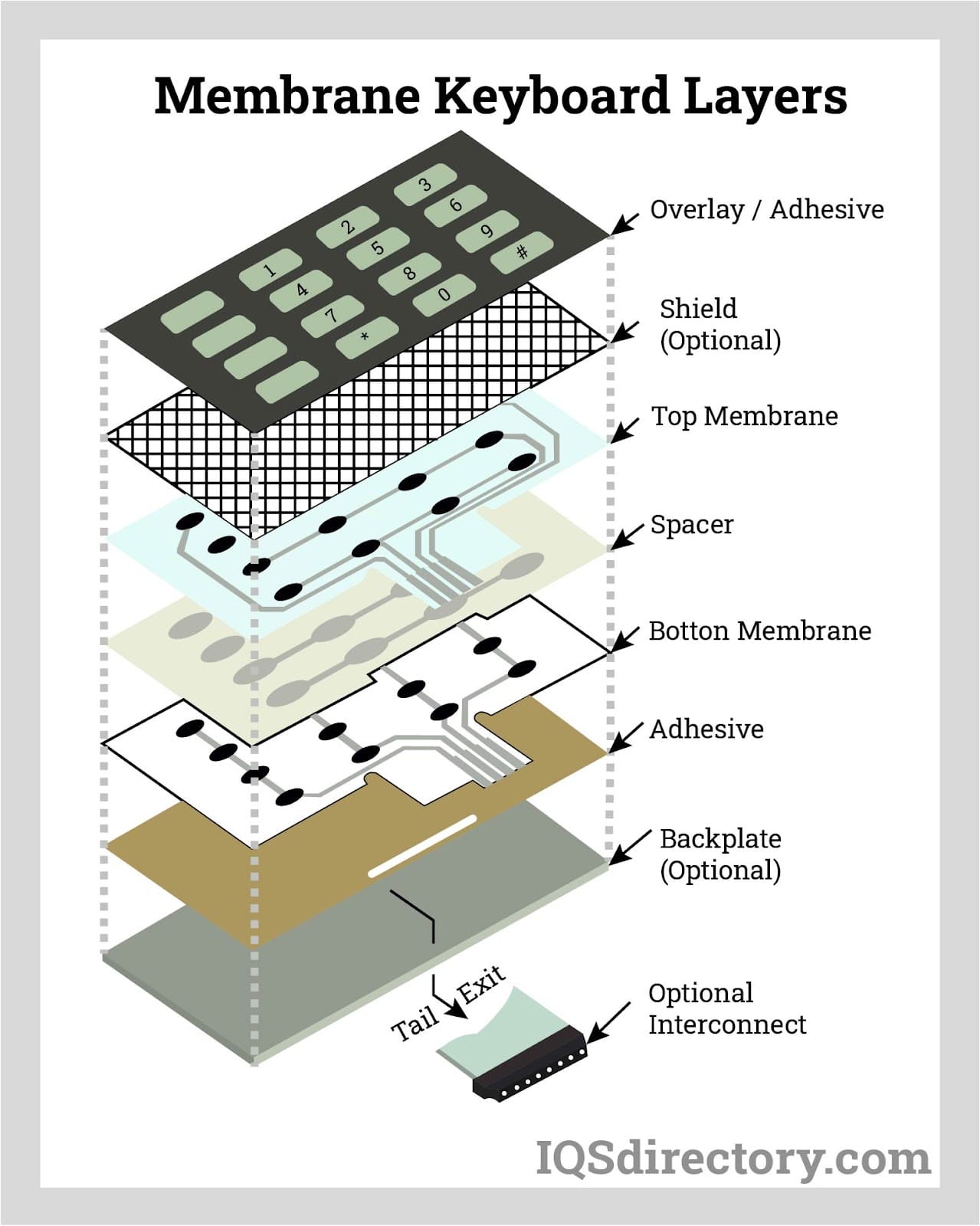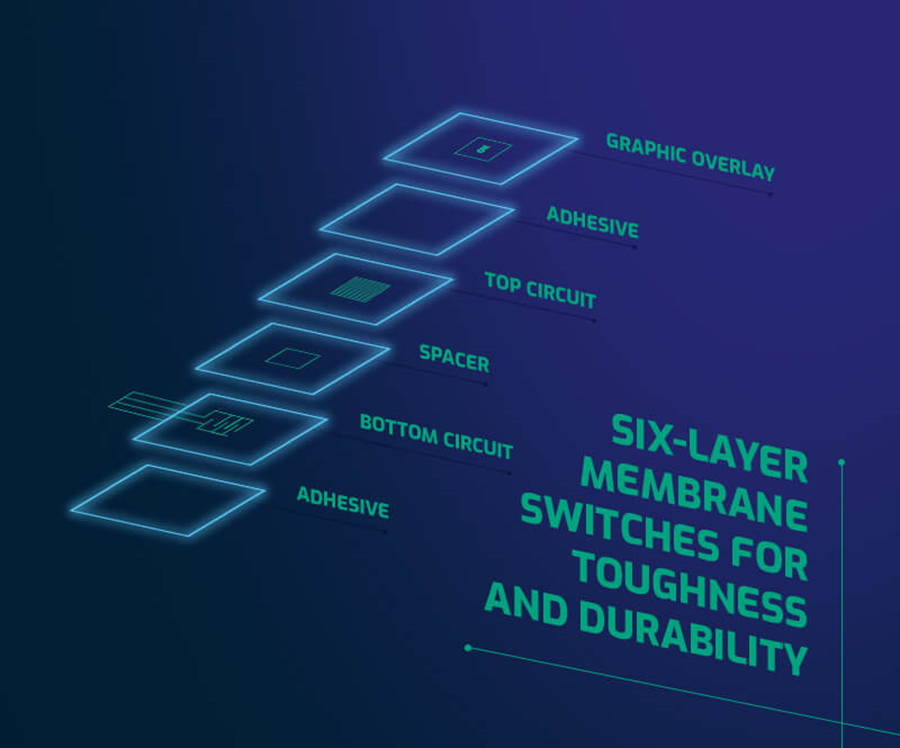Understanding the Significance of Membrane Switch in Modern Electronics
Membrane layer switches are important components in contemporary digital tools. They use a blend of functionality and design that enhances customer communication. Their lightweight and sturdy nature makes them appropriate for various applications. As sectors progress, the demand for personalization and progressed functions expands. Comprehending exactly how membrane layer changes add to technology exposes their importance in shaping the future of electronic devices. What lies ahead for this technology?
The Essentials of Membrane Switch Over Innovation
Although frequently overlooked, membrane layer switch modern technology plays an essential duty in the modern electronic devices landscape - membrane switch. These gadgets, composed of numerous layers, function as interface for different electronic items, varying from family appliances to clinical equipment. A common membrane layer switch includes a graphic overlay, a spacer layer, and a circuit layer, which are carefully constructed to create a practical interface.When stress is applied to the overlay, the circuit layer is completed, enabling signals to be transferred to the tool. This innovation is understood for its flexibility, allowing modification in form, functionality, and design to satisfy details user requirements. In addition, membrane layer buttons are light-weight and thin, making them appropriate for applications where room is a premium. Their sturdiness and resistance to ecological elements further enhance their appeal, ensuring they can stand up to rough problems while keeping capability. Overall, membrane switch technology is integral to producing easy to use and effective digital gadgets

Secret Advantages of Membrane Switches Over
Membrane layer switches deal numerous crucial advantages that make them a favored selection in numerous electronic applications. Their design enables for a compact type element, allowing makers to create lightweight and smooth devices. In addition, membrane layer switches are resistant to dust, moisture, and chemicals, which improves their sturdiness and durability sought after atmospheres. The tactile feedback provided by these switches can enhance customer experience, making them intuitive and very easy to operate.Furthermore, membrane layer switches can be personalized with diverse graphics and shades, permitting special branding possibilities. The manufacturing procedure is generally affordable, especially for high-volume production, as it minimizes setting up time and simplifies design. Membrane layer switches over require marginal upkeep, contributing to lower total operational costs. These advantages highlight their expanding popularity in contemporary electronic devices, where integrity and easy to use user interfaces are essential.

Applications Throughout Different Industries
The flexibility of membrane changes allows their prevalent fostering across numerous markets. In the clinical field, they are commonly made use of in diagnostic tools and client monitoring systems, using a durable user interface resistant to impurities. The automobile market utilizes membrane layer buttons for dashboard controls, improving individual experience with smooth designs that stand up to harsh problems. In consumer electronic devices, they offer as control board for gadgets such as microwaves and coffee manufacturers, offering a straightforward user interface that is simple to tidy. The aerospace sector utilizes membrane buttons in cockpit controls, where dependability and room effectiveness are paramount. Furthermore, the commercial sector leverages these buttons in machinery and control systems to assure durable operation sought after environments. This wide array of applications underscores the flexibility of membrane switches, making them important parts in improving functionality and user interaction across diverse technical landscapes.
Customization and Design Flexibility

Future Trends in Membrane Switch Development
Emerging patterns in membrane layer button advancement suggest an expanding focus on improved performance and combination with smart modern technologies. As consumer need for a lot more innovative electronic tools rises, makers are focusing on creating membrane layer switches over that not only serve standard functional roles but additionally incorporate features like touch level of sensitivity, backlighting, and haptic feedback.Furthermore, innovations in products are anticipated to boost longevity and ecological resistance, making membrane changes appropriate for diverse applications in sectors such as health care, automobile, and customer electronic devices. The combination of capacitive touch technology is most likely to come to be a lot more prevalent, enabling sleeker layouts and improved customer interfaces. membrane switch.Additionally, the increase of the Net of Things (IoT) is Related Site motivating the growth of membrane switches over that can communicate wirelessly with various other gadgets, boosting interconnectivity. Generally, the future of membrane switch modern technology appears encouraging, driven by advancement and the pursuit of easy to use solutions
Often Asked Questions
Exactly How Do Membrane Layer Switches Contrast to Traditional Mechanical Switches?
Membrane switches, being extra space-efficient and supplying a sleek layout, contrast with standard mechanical switches that give tactile responses. The former commonly include adjustable graphics, while the last generally ensure longevity and integrity in various applications.
What Products Are Frequently Made Use Of in Membrane Switch Manufacturing?
Membrane switches are normally generated using products such as polyester, polycarbonate, and published conductive inks. These materials offer adaptability, responsiveness, and resilience, making them appropriate for different applications in digital tools and interface.
Can Membrane Changes Be Repaired or Reused?
Membrane switches can frequently be repaired, particularly if minor issues emerge, such as glue failing or surface area damage. Full reuse is typically limited due to put on and possible deterioration of products over time.
Exactly How Do Environmental Elements Influence Membrane Switch Over Efficiency?
Ecological factors, such as temperature level, humidity, and exposure to chemicals, greatly affect membrane button performance. Severe conditions can bring about deterioration, affecting responsiveness and durability, inevitably jeopardizing the functionality of the device in numerous applications.
What Is the Common Life Expectancy of a Membrane Layer Change?
The regular life expectancy of a membrane layer button normally varies from 1 to 5 million actuations, depending on aspects such as use regularity, ecological conditions, and the products made use of in production, affecting resilience and website here efficiency long life. A typical membrane layer switch consists of a visuals overlay, a spacer layer, and a circuit layer, which are meticulously set up to create a practical interface - membrane switch.When stress is used to the overlay, the circuit layer is finished, enabling signals to be sent to the device. The tactile comments supplied by these switches can enhance user experience, making them very easy and user-friendly to operate.Furthermore, membrane switches can be personalized with varied graphics and shades, permitting for unique branding chances. As consumer need for much more advanced Website digital gadgets increases, makers are concentrating on developing membrane layer changes that not just serve basic functional duties but also incorporate features like touch sensitivity, backlighting, and haptic feedback.Furthermore, developments in products are expected to boost resilience and environmental resistance, making membrane switches ideal for varied applications in markets such as medical care, auto, and consumer electronic devices. The combination of capacitive touch modern technology is most likely to come to be a lot more widespread, enabling for sleeker styles and improved customer interfaces.Additionally, the surge of the Web of Points (IoT) is triggering the advancement of membrane switches that can interact wirelessly with other gadgets, enhancing interconnectivity. Membrane layer switches, being extra space-efficient and providing a sleek design, contrast with typical mechanical buttons that provide tactile comments